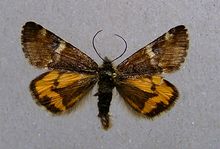Great virgin child
| Great virgin child | ||||||||||||
|---|---|---|---|---|---|---|---|---|---|---|---|---|

Great virgin child (male) |
||||||||||||
| Systematics | ||||||||||||
|
||||||||||||
| Scientific name | ||||||||||||
| Archiearis parthenias | ||||||||||||
| ( Linnaeus , 1761) |
The great virgin child ( Archiearis parthenias ), also called birch virgin child, is a butterfly ( moth ) from the family of the Spanner (Geometridae) or their subfamily Archiearinae. The big maiden child is one of the diurnal tensioners and flies in the sunshine. The moths are among the first active butterflies in spring, they can be observed from the beginning of March to around the end of April.
features
The male moths reach a wingspan of 31 to 36 mm (28 to 37 mm), the females 33 to 38 millimeters (32 to 38 mm). The head, thorax, abdomen and legs are very hairy. The eyes are comparatively small, the palps relatively short. There is a frenulum and a proboscis. The accessory tympanum is reduced. The forewings are gray-brown with a slightly darker gray to black marbling. There are usually three spots on the costal edge, but they can also be missing. The inner and outer transverse line is more clearly drawn in the females than in the males. The hind wings are bright orange-yellow with a brown band along the terms and apex and a large dark spot on the inner edge. The discal patch is large and brown in color. The fringes are checked in black and white. In the hind wing veins Sc + R1 is about half as long as the cell, the veins Rs and M1 are clearly stalked. The antennae of the male are slightly serrated, those of the female are simply thread-shaped.
The eggs are pale green and shiny.
The caterpillars are green and have three dark, fine dorsal stripes with yellowish edges. The stigmas are black, the yellowish point warts are covered with short black hair. The head is colored green. The four pairs of ventral feet are, albeit rudimentary, developed, which is actually a characteristic of the owl butterflies .
The pupa is shiny red-brown.
Similar species
- Middle virgin child ( Boudinotiana notha (Hübner, 1803)).
Geographical distribution and habitat
This species can be found in raised bogs , clearings and birch forests, also in heathland near birch trees. It is spread over all of Europe north of the great mountains (Alps, Carpathians), but is absent in Ireland. An island-like occurrence is known from the Pyrenees . In the east the distribution area extends over Siberia to the Russian Far East and Japan. In the south, the species is also found in northeastern Turkey and the Caucasus region.
In the north the occurrence is more regular than in the south, and in the southern Alps this species occurs up to about 1000 m above sea level.
Way of life
Archiearis parthenias forms one generation per year. The moths fly from the beginning of March (sometimes even in February) to the end of April. However, it is highly dependent on the region. In Northern Europe and at higher altitudes, the flight time is correspondingly later; u. U. from the beginning of April to the end of May. The maximum is already reached in the period from mid-March to mid-April. The moths are diurnal and visit pussy willows, but also leaking tree sap and fresh droppings. They can be found in the morning on the ground in the warm spring sun, where they warm up and drink drops of dew. When it's cold, they become so stiff that you can knock them off the leaves. The caterpillars hatch at the end of April or beginning of May after the birch leaves shoot, in Northern Europe and the like. U. only in June to July. They are oligophagous and, in addition to the main food plants (various types of birch), also feed on rowanberry ( Sorbus aucuparia ) and beech ( Fagus ). They prefer younger trees. The first stages of caterpillars feed on the catkins, later stages stay between loosely interwoven leaves and feed on tender, freshly sprouted birch leaves. Pupation takes place in rotting wood or under the tree bark. The pupa overwinters, sometimes overpowers a winter. The moths hatch from mid-February to around mid-April.
Systematics
In East Asia, several subspecies of Archiearis parthenias can be distinguished:
- Archiearis parthenias parthenias , in Europe and Western Asia
- Archiearis parthenias sajana ( Prout , 1912), Kamchatka , Amur , Primorye , southern Siberia , northern Mongolia
- Archiearis parthenias hilara Sawamoto , 1937, Sakhalin
- Archiearis parthenias bella Inoue , 1955, Japan
- Archiearis parthenias elegans Inoue , 1955, Japan
swell
Individual evidence
literature
- Axel Hausmann: The Geometrid Moths of the World . In: Axel Hausmann (Ed.): The Geometrid Moths of Europe . 1st edition. Volume 1: Introduction. Achiearinae, Orthostixinae, Desmobathrinae, Alsophilinae, Geometrinae. Apollo Books, Stenstrup 2001, ISBN 87-88757-37-4 (English).
- Walter Forster , Theodor A. Wohlfahrt : The butterflies of Central Europe. Volume 5: Spanner. (Geometridae). Franckh'sche Verlagshandlung, Stuttgart 1981, ISBN 3-440-04951-5 .
- Günter Ebert (Ed.): The butterflies of Baden-Württemberg . 1st edition. tape 8 . Moth VI. Spanner (Geometridae) 1st part. Eugen Ulmer, Stuttgart 2001, ISBN 3-8001-3497-7 .
- Patrice Leraut: Geometrid moths . In: Moths of Europe . 1st edition. Volume II. NAP Editions, 2009, ISBN 978-2-913688-09-4 (English).
Web links
- Lepiforum e. V. Taxonomy and Photos
- www.schmetterling-raupe.de
- Natural History Museum Stockholm (Swedish)
- Markku Savela: Lepidoptera and some other life forms (English)
- Archiearis parthenias at Fauna Europaea
